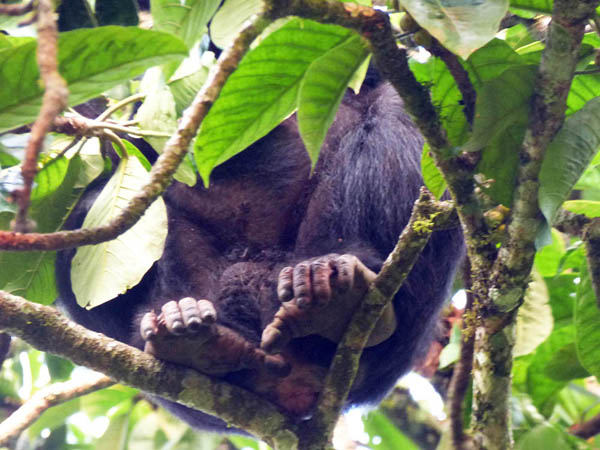
Welcome to Diary of a Muzungu! This week’s guest post is by Clare Park, a British tourist who visited Uganda with her family recently. She writes “We are all keen nature and animal lovers and have been to Africa several times before, but never Uganda. We all had a truly, truly wonderful time! Every part of our Uganda holiday was so special. We relive it often through the photos and videos and will absolutely return.”
A highlight of Clare’s trip was chimp trekking in Kibale Forest – it makes exciting reading!
Clare writes:
I have always wanted to see chimps in their natural environment. I studied clinical language sciences at uni. This included linguistics and the study of chimp versus human communication. It was fascinating. I love all animals, but particularly primates, and would one day like to work with them – ideally studying their non-verbal language.
We recently had the privilege of spending two weeks with my cousin’s cousin Malcolm Wilson who lived in Uganda for 17 years and now lives in South Africa. Malcolm visits Uganda regularly to guide bird (and bird ringing) trips. Kibale Forest was on the circuit he had planned for us to share the wonders of this beautiful country. We stayed with a friend of his who has studied chimps for many years: Julia has a beautiful home overlooking Kibale Forest. It’s a very special place to stay.

The Park family used Sunbird Hill as their base while they were chimp tracking in Kibale Forest. Clare is seated top left. Expert ornithologist and bird ringer / birder Malcolm is seated bottom left.
We were all overwhelmed when we arrived at the stunning location. Sunbird Hill – where Julia has built her family home – is now offering B and B. We were greeted so warmly and, as the sun was setting, were offered gin and tonic – but no ordinary gin – Uganda Waragi gin in a sachet! Even better, there was ice and lemon to accompany the gin – things which we hadn’t been able to get since arriving in Uganda and staying at various other lodges. It was a perfect drink in a perfect location to start our chimp trekking experience.

A pair of Chimpanzee feet, high in the canopy of a fig tree. This photo was taken from Sunbird Hill, Kibale Forest edge
The following day my husband Mike, daughters Amy (22) and Bea (17) and son Ed (19) set off to do our much longed-for chimp trekking. Our driver took us to the Uganda Wildlife Authority office 3 km from Sunbird Hill to register for our chimp trekking before setting off. Here we were assigned a ranger who had years of experience with the chimpanzees. The rangers know this chimp community of Kibale Forest intimately, having studied them closely and worked to habituate some of the chimpanzees. Habituation means that when tourists enter Kibale Forest, chimps see them as neutral and continue about their daily lives as if no-one is watching.
After a briefing from our guide about “the do’s and don’ts of chimp trekking” we soon entered Kibale Forest’s tall tree canopy and rich vegetation. Ahead, rangers communicate the location of where the chimps are to be found. We soon located an adolescent female chimp of around 13 years old. She was feeding from a tree when we first saw her, eating some berries. We stood and looked up at her high on a branch enjoying her feast. She seemed unperturbed by us looking on. She then climbed down the tree and set off on the ground at quite a pace. Our ranger indicated for us to follow her, keeping a distance behind her of approximately eight metres. She would occasionally stop, have a look around, perhaps feed on something and then set off again. We had the privilege of her allowing us to follow her on the ground for about forty minutes. At one point she stopped and tore a piece of bark from a tree and started to lick it for fluid and scratch it to remove the bugs. She then put it on her shoulders to carry and set off again. The bark fell off after a few paces.
When you see a chimpanzee with a pink and swollen rear, it indicates she is in season
We were later informed by Julia, the resident chimp expert at Sunbird Hill, that this was a very unusual thing to observe. In her years of studying chimps, Julia had never seen a chimp attempt to carry anything on their shoulders. She was quite excited by what we had seen. We even had video footage to show her.
The female teenage chimp then climbed high into a tree and started feeding on fruits again. We were joined by several other groups of trekkers at this point and it did not seem right to stay any longer, so we headed back to base.
Even though it is usual to see large groups of chimps when trekking in Kibale Forest, the intimacy of being able to follow one chimp at proximity and to observe her going about her daily routine was very special. We learnt a lot about how she moved, fed, climbed, rested, broke wood and carried it. It was interesting to observe her character and note that she wasn’t seeking the company of other chimps. Julia commented that it is quite rare to see a chimp of this age on her own for such a lengthy period of time – and that she let us follow her. We all concluded that perhaps this female chimp had just needed some ‘time out’ on her own!
[A very short clip!]
My family were all very humbled by the time we spent observing her and we took many photos and videos. Nothing quite captures the specialness of seeing a chimpanzee in their natural environment.
The following day I decided I would return and do another trek: I needed another ‘ fix’ of chimps. One morning wasn’t enough for me, given my fascination with them.
After another early morning briefing, I was assigned a group with five other trekkers. Our ranger Moses was informed early on that there was a community of chimps nearby. We set off at a pace.
We approached a slight clearing in which sat several magnificent tall trees with their branches sprawling out horizontally, forming a ‘climbing frame’ for the chimps. Here the screeching of these fascinating creatures started and just didn’t stop. Chimps charged through the undergrowth, banging their feet on tree stumps to create a sound like a drum. Their mouths were open wide, baring their teeth as their vocal sounds rose in a crescendo. There were chimps everywhere – high in the canopy, on the ground, still, active, noisy, quiet – so many, I lost count. Old, young, big, small, feeding, playing, grooming, fighting. The behaviours I observed in that hour of observation are almost indescribable. Every few seconds there was a new noise to turn to, a rustle in the vegetation high or low, the sounds of animals swinging between trees and often dropping from height in pursuit of another chimp, either in play or threat. I took so many photos trying to capture the chaos of what I was witnessing; recordings of their non-verbal behaviour and audio recordings of their vocal communication.
Three chimpanzees grooming. Kibale Forest, western Uganda
We happened across three mature male chimps, sitting one behind each other on a broken branch on the ground. They all sat facing in one direction, the front one turning to the one behind sporadically to groom him. We were less than a few metres away. It was mesmerising watching them.
Two chimpanzees grooming. Kibale Forest, western Uganda
Two younger male chimps sat on the ground, taking it in turns to groom each other, working methodically from the head to the back to the legs. There seemed to be an unspoken rule of how long they groomed before turning around and letting the other groom in return. The non-verbal communication was fascinating to observe.
![]() Another chimp lay on his back on some leaves to rest just in front of us. He rolled onto his side after a big yawn and lay there as if to say, ‘now that is more comfortable.’ It seemed so human.
Another chimp lay on his back on some leaves to rest just in front of us. He rolled onto his side after a big yawn and lay there as if to say, ‘now that is more comfortable.’ It seemed so human.
After the hour of observation (which passed in a flash) we headed back to Uganda Wildlife Authority’s chimp trekking base office at Kanyanchu. Our whole group were somewhat overwhelmed and therefore quiet. Words couldn’t express what we had shared. I had several moments during the hour when my emotions got the better of me; I just welled up with joy at what we were experiencing. It was all just too much, in the most beautiful of ways.
As we headed back to base we had to cross the road which has recently been upgraded and tarmacked for improved access to the tourist area of Kibale Forest. Whilst it was probably needed at a practical level, there were grave concerns around how the increased volume and speed of traffic would impact the safety of the chimp communities. As we reached the tarmac we observed a community of chimps crossing the road – oblivious to the danger of the traffic. Fortunately, the rangers were there to intervene and stop the buses, coaches and other vehicles hurtling around the blind corner just as the entire community crossed: young and old, a baby on a mum’s back. We all held our breath as we watched them safely reach the other side of the road where the forest continued. It was a poignant end to an overwhelming experience and one couldn’t help wondering if modernising the road so traffic could pass through at greater speeds was in fact a big mistake. Time will tell – but there seemed to be much concern, understandably from the rangers.
Once back at UWA’s chimp trekking office, I said farewell to my group members and UWA guide Moses. He had observed how emotional I had been several times and realised just how very special our trek had been. The rangers said I would always be welcome there if I ever wanted to pursue my dream of watching and analysing non-verbal chimp communication, a life-long dream.
One day I will be back in Kibale Forest.
There was the option to do a further day in which you join a habituation group and go out with the rangers and researchers to continue the habituation of other chimp communities. Sadly, my family and I had to head off the next day.
Back at Sunbird Hill, my family were keen to hear how I had got on. At first, I felt reluctant to share just how different that morning’s chimp trekking had been compared to the day before. However, hand on heart, I can’t say one experience was better than the other. They were both totally unique. Observing the female chimp had been so intimate as we got to learn her movements and expressions. The second morning was such a contrast – I lost count of the number of chimps we saw – the noise, the chaos, the movements, the high energy of these fabulous creatures as they went about their everyday socialising. However, I was completely mentally exhausted after the second morning and, once I got back to our treehouse-style hut at Sunbird Hill, I found myself crying uncontrollably at the sheer wonder of what I had seen in the last 24 hours. It was everything – and way more than I could ever have imagined. It is quite impossible to translate the joy and happiness I experienced watching these highly intelligent and fascinating creatures. They are so close to us humans it is quite remarkable – and a little bit ‘Planet of the Apes’!
I think about Kibale Forest often and I know I will go back in some capacity to top up this beautiful lifetime experience.
The muzungu: Thanks Clare for sharing your fantastic experience! We look forward to seeing you again very soon 🙂

























